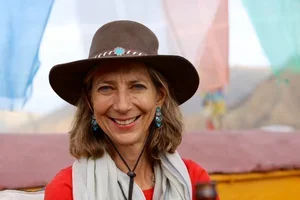Bennington Stories: Claire Burkert '80
Claire Burkert ’80 left a more traditional college experience to attend Bennington as a junior. The choice has led her to a creatively inspired life helping artists and artisans around the world empower and support themselves.

Bennington Stories is a series of first-person messages that share voices from throughout the unique and multifaceted Bennington community.
Choices Beyond Imagination: How the Bennington Experience Opened the World
I transferred to Bennington from an Ivy League university in my junior year. “You did what?” was the usual response to my move. But I knew what I was seeking. At the university I received excellent instruction in painting, but the studio was closed after class. We weren’t expected to return until the next class. Moreover, many of my classes were with hundreds of students. I was in awe of my professors, but I could never meet them. And I was missing a community of like-minded people my age who wanted to share their passion for art.
In the Visual and Performing Arts Center, known as VAPA, I had my own studio. Next to mine was that of the artist David Brody, now professor of art at the University of Washington. He would peer around from his side of the wall and offer me pointers. Later, I studied printmaking with Orlando Condeso, and I would often stay in the printing studio working with total concentration until 3 am.
During my final winter term, Orlando invited me to intern in his print workshop in Chelsea. There, wearing masks to protect us from the benzine fumes, we made prints with huge plates for renown artists such as Philip Pearlstein and Alex Katz.
I remember when a dealer complained a portrait by Katz was quite dull; Orlando added a bow tie. One day, still wearing my ink-stained t-shirt, I carried a portfolio of valuable prints under my arm to a dealer uptown. How empowered I felt, at the age of twenty, to be so deeply embedded in the world of making art in New York City.
My work during my first winter term, interning at Boston Magazine, had been less interesting; but nonetheless, I was staying in a sweet apartment in Cambridge, learning to cook Greek food from my female landlords, and visiting the Museum of Fine Arts every free Tuesday evening. As I did later in New York City, I felt free, independent, and able to seek my own happiness in these cities.
Writing was my other interest, and how I loved not only my courses but also getting to know Ben Belitt, Nick Delbanco, Stephen Sandy, and George Garrett. My final thesis reflected my interests in writing and art, as it focused on writers who were artists and artists who were writers. I wanted to explore why Edward Lear, William Morris, John Ruskin, and others wanted to do both art and writing.
When I had the chance to deliver my thesis in a small auditorium, George Garrett was chuckling throughout and told me he found it very funny. This befuddled me, as I had not intended my thesis to be humorous but rather an honest exploration that would explain my own internal split. But my instructors were listening to me. They made me believe that whatever I had to say, be it in art or in writing, had some significance.
Liz Swados was our commencement speaker, and her words, to go forth and do what we wanted to do, inspired me. I left Bennington with the notion that I could find a path that was not defined by job listings. Those two years at Bennington—the winter terms and one summer workshop as well—gave me the confidence to make choices which, at the time, were still well beyond my imagination.
After completing a fiction writing degree at Brown, I made my way to Nepal, believing I would be able to write better about American life from a distance. But there was no looking back. Within a few years, I had encountered Maithil women in the south of Nepal who painted on the walls of their houses. I documented their paintings and wanted to write about them.
I received a grant to establish a women’s income-generating project wherein the women painters would make and sell paintings for income. This had been done with the Maithil culture in India but not in Nepal. The women came from a strict Hindu society and were, at first, not allowed to leave their houses.
Eventually, we formed a women’s cooperative, The Janakpur Women’s Development Center. The JWDC has since brought renown to hundreds of women and their skills. Some of the painters are now recognized both in Nepal and internationally.
Based on my work with the Maithil painters, I became involved in launching crafts projects with ethnic minorities in communities all around Vietnam. After ten years in Vietnam, I began to consult with artisans in India, Tibet, Myanmar, Gaza, and Turkey. My home base for thirty years has been here in Kathmandu, Nepal, where I continue work with the JWDC and have written a book on Himalayan architecture and design.
The story I mean to tell is that my life has been creative and unpredictable. It has not always been easy, yet it has been ultimately rewarding. I am proud of my choices, and I am very grateful for my Bennington years which ingrained in me: “believe in yourself, stretch your imagination, and just go do it.”